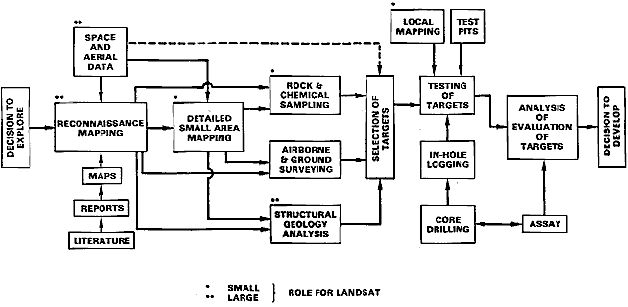
MINERAL AND PETROLEUM EXPLORATION

Starting with first stage or reconnaissance mapping of a broad region, the flow of activities leads to selection of specific targets that narrow the total area to a few locations that can be effectively and economically examined in detail. Landsat, SPOT, and other space systems provide the regional inputs to visual databases that can be correlated with existing information from maps and publications. Computer image processing can convert "raw" data into specialized thematic maps that emphasize certain characteristics of surface materials (telltale guides) and structures known from experience to associate with conditions in which ore deposits and hydrocarbons are likely to be concentrated. Once candidate target areas have been designated, more precise mapping using imagery as a base but supported by ground checks and even detailed (local) mapping is called for in pinpointing the final targets. These can also be examined by appropriate subsurface geophysical methods such as seismic refraction and gravity surveys (those methods may be applied early on as a means of focusing in on these ultimate targets). While information up to this point may strongly support presence of economic deposits, the decisive test will nearly always be to drill into the promising site(s) to recover samples for evaluation of economic worth or, in the case of oil/gas, to actually encounter the presence of commercially viable hydrocarbons.
Space-acquired data - principally images - supercede previous approaches which relied on extensive ground and aerial surveys simply by opening up large tracts of land (a full Landsat scene covers more than 34000 square kilometers [13000 square miles]) that can be examined as units both by photointerpretation and by computer-aided analysis (including the approach known as Geographic Information Systems [GIS] described in Section 15). After appropriate processing, these full scenes will likely reveal much smaller locales that display guides to mineralization or oil/gas deposits. This has the potential for major exploration cost savings in that large areas of obvious unsuitability can be eliminated and field efforts confined to localized areas that show these favorable conditions. We will illustrate this concept by first demonstrating Landsat's capability to bring out surface signs of possible mineralization and then by evaluating a case study which considers both surface alteration and structural control that may point to underlying oil and gas traps.
Prospectors and miners have for centuries - and exploration geologists for the last one hundred years or so - sought certain telltale signs of valuable mineralization - especially gold, silver, copper, nickel and other metals - that appear as abnormalities or anomalies at the Earth's surface. Most widespread among these guides is "gossan", a miner's term for what you might simply describe as "rust". It is, in fact, a mix of several forms of hydrated iron oxides, including the mineraloid group "limonite" ( FeO(OH) nH2O, that develop most commonly when other iron-bearing minerals react with water and other chemicals during the natural weathering or alteration processes. The brownish to yellow-brown color of soils and yellows and oranges of many sandstones (especially in the U.S. West) owe those distinctive tints to these secondary iron compounds; the reds in rocks usually result from the presence of hematite, a non-hydrated iron oxide ( Fe2O3). The chief reason that gossan forms in areas where useful metals are concentrated is that pyrite, (FeS2), a common mineral also known as "fools gold" because of its brassy yellow metallic color, is deposited along with these other substances from hydrothermal (hot water) and other kinds of solutions that usually are released from hot magmas at depth to migrate upward into the crust until they encounter conditions favoring precipitation as ore minerals. The most common ores of silver, copper, lead, zinc, nickel and cobalt are compounds of these metals with sulphur (as sulphides). While several of these also have discrete alteration products, the most conspicuous (whether seen from a pack mule or in a color aerial photo) is normally gossan and related iron products derived from the chemical breakdown of pyrite. Secondary minerals (including sulphates, carbonates, and clay minerals) that also may form by alteration afford additional clues to the possible localization of prized metals. Of course, the presence of gossan does not automatically guarantee occurrence of economically extractable metals as iron sulphides (usually worthless) may be the only or dominant mineralization.
The subscene, about 35 km (22 miles) on a side, resides within Beaver Co., Utah and is about 24 km (15 miles) west of the small town of Milford and 64 km (40 miles) north of Cedar City, gateway to Zion National Park to its south. The physiographic setting places this area well within the Basin and Range Province which, geologically, is a series of generally north-south trending mountain blocks that are upfaulted between downdropped valleys or basins. The area lies within the High Desert country of the U.S. Southwest. On the left side of the image is a part of the Wah Wah Range, a typical block-fault mountain system. To the right are a group of isolated hills made up of eroded volcanic flows and small outliers, such as White Mountain (gray roundish landform near image center), of Paleozoic sedimentary rocks. Lowlands within the scene extend into basins filled with eroded debris from the uplands including alluvial wash (such as the bright toned area in left center) that form sloping aprons. Distinguish this from the several clouds and their shadows. Just to the left of White Mountain is an elongate (E-W) area, about 8 km (5 miles) in length, characterized in this false color version (Bands 2-4) by blotchy orange-brown to tan tones. This is a classic expression of gossan staining associated with a mineralized zone.
Code 935, Goddard Space Flight Center, NASA
Written by: Nicholas M. Short, Sr. email: nmshort@epix.net
and
Jon Robinson email: Jon.W.Robinson.1@gsfc.nasa.gov
Webmaster: Bill Dickinson Jr. email: rstwebmaster@gsti.com
Web Production: Christiane Robinson, Terri Ho and Nannette Fekete
Updated: 1999.03.15.